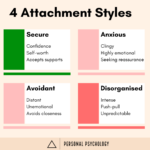Rejection sensitivity means having a specific sensitivity to rejection, or rejection cues (thinking someone may reject us), leading to overreaction to these perceived threats of rejection. Rejection sensitivity is most often explained by early childhood experiences with parents, caregivers, and significant others when the child’s attachment needs are not well matched.
Table of Contents
The hypersensitivity to real (or perceived) rejection is largely driven by expectations of rejection, and the increased negative emotions around rejection, which are formed during the early years of interactions with others.
Rejection sensitivity also creates a low threshold for perceiving interactions with others as negative or rejecting, taking negative cues as personal attacks, and responding to these with intense emotions. This perception-response then creates a feedback loop, leading to self-fulfilling prophecies, likely worsening an individual’s behaviour throughout their life. In essence, rejection sensitivity focuses on the complex processes linking early experiences with future social interactions.
High rejection sensitivity – intense reactions
The activation of our defensive motivational system in situations where rejection may happen depends on the positive or negative content of the interaction (called valence; the interaction may be perceived as positive or negative). The intensity of the response then depends on the level of arousal in each situation.
When our defence system is activated in a high-arousal, negative-valence context, responding to perceived danger, it amplifies our responses to rejection cues — and we respond with more anger, for instance.
Why do I feel left out when I’m with my friends?
People with high rejection sensitivity are usually more uncertain about whether they will be accepted or rejected in situations where rejection might occur. They tend to anxiously expect rejection, and this anxious expectation triggers the activation of the defence system, which then puts them into an overdrive state.
When an interaction is more unclear, the potential rejection cues are often interpreted in a way that aligns with the rejection expectations. It may feel like overreacting is a “safer option” rather than overreacting to mild cues, as ultimately, they might turn out to be rejecting.
If there is a chance to interpret a cue as rejection, people with high rejection sensitivity will likely interpret it as rejection and will respond with intense emotions or behaviours.
The defensive motivational system gets activated in people with high rejection sensitivity, as they tend to expect rejection in interpersonal situations. It helps monitor and detect threat-related cues, preparing the individual for a swift response when the danger of rejection is perceived. This heightened sensitivity to rejection explains why high-rejection sensitivity people interpret others’ behaviours as rejecting and respond intensely to perceived rejection. We tend to find what we expect to find, in this case, rejection from others.
Low rejection sensitivity
On the other hand, low rejection sensitivity individuals tend to take acceptance for granted and are less worried about the possibility of rejection. In turn, they do not experience heightened activation of the defensive motivational system. This difference in responses to acceptance and rejection cues explains the lowered reactions to ambiguous rejection cues.
High rejection sensitivity individuals tend to be more vigilant and on edge in situations where rejection might occur, while low rejection sensitivity individuals do not exhibit the same heightened sensitivity to threat cues.
Evidence for high rejection sensitivity and high emotional state
A study found that showing rejection-related images increased the chance of startle response in individuals with high rejection sensitivity. At the same time, this effect was not observed in people with low rejection sensitivity.
This means people with high rejection sensitivity have a high, typically negative arousal when experiencing or thinking about rejection. As such, negative interactions with others can make high rejection sensitivity individuals feel threatened and respond with more extreme behaviours when they perceive rejection.
High sensitivity – everything feels like rejection
High rejection sensitivity individuals are more likely to see negative or even unclear interactions with others as personal remarks or intentional rejection. They are also less likely to consider alternative explanations for perceived rejection, which often leads to overreaction or defensive behaviour, even when it is not justified. These reactions are often so inappropriately intense and defensive that they create new conflicts in relationships — conflicts that did not exist in the first place.
Problems starting in childhood
The unhelpful behaviours associated with high rejection sensitivity are not limited to adult relationships and often can be observed in children. High rejection sensitivity children may appear as aggressive and antisocial and might be experiencing difficulties in relationships with peers and teachers.
The vicious cycle
Rejection sensitivity creates a vicious cycle, starting with expectation rejection, and responding with intense behaviours that ultimately fulfil those expectations as others tend not to tolerate or even understand the intensity and hostility in benign situations.
While rejection sensitivity might seem like a dysfunctional system, it is important to understand that it is a defence mechanism against rejection by significant others or friends. Unfortunately, the initial self-protective nature of the rejection sensitivity can and does turn into maladaptive behaviours and patterns when activated in situations that do not require strong defensive responses.
Rejection expectations and emotion regulation
A high rejection sensitivity dynamic does not always lead to intense and maladaptive behaviours. Being able to regulate our own emotions, for example, can reduce the likelihood of responding intensely and hostilely to ambiguous rejection cues. Ultimately, our responses to perceived o real rejection are driven by many factors, not such rejection sensitivity alone.
There are several ways to stop the maladaptive patterns that can develop in response to the threat of rejection, such as emotion regulation skills, and “Rejection Prevention” or “Efforts to Prevent Rejection” strategies.
Rejection prevention, pleasing, and the loss of self
Rejection prevention strategies are used to avoid rejection by preventing situations that might create rejection. This often means actively trying to please others. While these strategies can be adaptive when used appropriately (not forgetting a birthday), they may lead to a “loss of self” where one’s own goals and interests become secondary to maintaining a relationship (“I like guitar because my friend likes guitar”). High rejection sensitivity individuals might engage in these behaviours when they expect rejection but hope for acceptance still exists — “if I try extra hard, they will not reject me”.
Efforts to prevent rejection can also lead to self-defeating behaviours, such as engaging in harmful actions to maintain a relationship.
For example, people with high rejection sensitivity are often more willing to do things they consider wrong to keep a romantic relationship, such as engaging in sexual acts that they otherwise would not want to do. Additionally, they may practice self-silencing and not tell important information about themselves that is at odds with others’ values just to prevent potential rejection. While these behaviours are aimed at preventing rejection, they often lead to an unstable sense of self, as individuals adapt their preferences, goals, and beliefs to align with those of important others in an attempt to maintain a relationship and connection.
Pleasing and hostility -“Who am I?”
Trying to blend in and please others may have negative effects. Pleasing and over-accommodation can lower our mood and damage our self-concept, leading to hostile reactions when rejection is perceived, despite our best efforts to prevent it. High rejection sensitivity people sometimes start relationships over-eagerly but become increasingly anxious over time, expecting rejection. This anxiety then leads to a shift from trying to please others before rejection to hostility after real or perceived rejection.
High rejection sensitivity individuals may define themself solely in relation to others, leading to concerns about losing their identity if a relationship ends, often questioning “Who am I?” after a breakup. This self-presentation in relationships can lead to a lack of clarity about self-concept and create more self-defeating behaviours as they try to prevent threats to their sense of self.
Struggles with self-regulation and perspective-taking
High rejection sensitivity individuals often struggle with self-regulation, as in, being able to resist acting on impulses. This can make it difficult to react appropriately to rejection, which is a very emotionally charged situation. Poor emotion regulation is often paired with difficulties shifting attention away from rejection cues, making them more prone to think the other person is rejecting them.
The focus on potential rejection and inability to contain behaviours leads to destructive behaviours without considering the long-term consequences.
Importantly, not all high rejection sensitivity individuals have extreme behaviours. Some individuals can stop maladaptive responses (such as anger) and use adaptive ones (problem-solving) when they face potential rejection. One important difference is the ability to stop their “hot” response to raw emotions that invariably come after rejection. Those who can control their automatic defensive motivational system reactivity can better deal with rejection and behave in ways that are compatible with their long-term relationship goals.
The ability to refocus attention and to use cognitive reframing, to rely on “cool” thoughts and responses to situations is essential for regulating behaviours. Those who can maintain their frustration levels can inhibit impulsive reactions and access reflective processes to negotiate with others and maintain long-term relationships.
How do I fix feeling left out?
Managing by not fixation on rejection
High rejection sensitivity people who can regulate their emotions better by strategically shifting their attention and avoiding fixing on rejection cues. This helps them to lower the activation of their defence system and allows them to focus on other, situational information and alternative explanations more than on a potential rejection.
Their ability to make finer distinctions between ambiguous behaviour and intentional rejection makes them less likely to incorrectly label mixed messages as rejection, and that in turn helps them not to react with rapid fight-or-flight or reassurance-seeking responses.
Focusing on long-term goals
People who are good at waiting for things, rather than acting on impulses (in other terms, who have high delay-of-gratification ability) can use mental strategies to transform and reinterpret the meaning of threatening situations, such as a partner’s negative behaviour.
Instead of ruminating and catastrophising about a small event, they may interpret it as a simple difference of opinions, or a temporary, situationally created friction which is a normal part of every relationship. This reinterpretation and contextualisation help them to look at the rejection threat as a small hiccup in the broader long-term context.
High rejection sensitivity individuals with strong self-regulation can also maintain focus on their long-term relationship goals, helping them stop impulsive and destructive behaviours. Instead, focusing more on better coping strategies helps with maintaining long-term relationships and goals.
Rejection sensitivity and mental disorders
While rejection sensitivity is not a mental disorder, it is often associated with or may lead to, mental health issues. There is a moderate association between rejection sensitivity and depression, anxiety, loneliness, borderline personality disorder, and body dysmorphic disorder. In this regard, it is important to highlight that this is not a causation (rejection sensitivity does not create a mental health problem), but rather, an association (people with these disorders also often struggle with rejection).
Interestingly, these associations are not typical to gender, age, the way rejection sensitivity is measured, or the country the person is living in, suggesting that rejection sensitivity is universally linked to mental disorders.
Both CBT therapy in Sydney, and DBT can be helpful to manage intense emotions that are associated with rejection sensitivity. If you are ready to start your journey, book a psychologist online.
Summary
Rejection sensitivity is both a socially and mentally (cognitively) influenced construct that explains how certain social situations trigger anxious expectations of rejection. People with high rejection sensitivity are more sensitive to negative cues and personalise these cues more often.
Importantly, even before an actual rejection occurs, the internalisation of rejection cues leads to efforts to prevent rejection, often at the expense of personal goals, leading to pleasing behaviours and losing a sense of self in the process. After a rejection occurs, intense negative emotions and destructive behaviours follow, unless self-regulatory skills are in place to prevent overreactions.
If the person fails to control their responses to even mild or ambiguous cues, then these emotional and behavioural overreactions turn their rejection fears and expectations into reality as others often leave the relationship as they cannot tolerate these behaviours, further reinforcing their fears of rejection: “I knew it all along”.
Please note that this blog post by Personal Psychology is not intended to provide professional advice. If you or someone you know is experiencing mental health difficulties, it is important to seek help from a qualified healthcare professional.





